Research Article :
Amrosius
Masrikat and Hendry Izaac Elim Sea worms or sand worms were widely spread on earth
generally in beach areas with a series of different taxonomy sizes. There made
a variety of the genus as well as species of such interesting worms. This study
explores that traditional medicines fabricated using Kian sand worm (Siphonosoma ur-pulau) with two types of
grain sizes. Our significant findings show an attractive potential of it as
toxic absorption based traditional medicine besides its normal use as daily
foods in the Tual region of Maluku province in the eastern part of Indonesia.
Such noteworthy identification was tested and identified in the grain rough
size medicine with low concentration related to its integrated multitasking
response of electrical, optical and chemical characters such as its lowest
absorbance at a moderate transparency of 0.271a.u (T~53.528%) pH~5.09, and
stable voltage under thermal effect ~0.7V. This invention unlocks a various
opportunity of the use of Kian sand worm as a multitasking traditional
medicine. The mystery of healthy natural foods involving herbal
medicines extracted from parts of plants or traditional medicine made by parts
of animals has been a long time trust among ordinary people with different
tribes and nations in small villages or remote islands on earth. Such
incredible simple science from generation to generation from ancient times has
been an evident history inherited to current 21st century people worldwide. As
the advancement of Nano medicine with multitasking understanding or multi-agent
system is acceptable among interdisciplinary scientists as well as unconscious
ordinary society, the life of healthy people has been a good example to improve
cultural behaviors among person to person interactions daily in current ~7.8
billion world people [1-22]. Even though the space
of human being on earth has been shrinking to be ~ 50.33 Person/km2 in the
whole living land area of earth surface. The momentum of lifestyle is a good
source of energy contribution for maintaining human being healing such as both
enzymatic and non-Enzymatic types of giant natural antioxidants
to develop either herbal medicines or traditional medicine, for instance in sea
or sand worms extracted and taken from the parts of sea worms [1-22]. Such sand worms mostly stayed in the beach sand areas or a
land surface on earth very closely connected to the ~70% of world seas/ oceans.
Therefore, it is interesting to investigate their unique physical chemistry
chemical physics characters for a possibility in integrated traditional
medicine based on electrical, optical and chemical responses, respectively.
Many deep investigations have been carried out about different types and
locations of sea or sand worms all over the world with their focuses on typical anatomy,
environmental behaviors, and food processing and
products by using the identification through DNA barcoding,
molecular detection worm relationships novel antithrombotic
protease protective effects of polysaccharides bioturbation and aquaculture,
ecological impact and counterplan [1-4, 23-29]. In this simple and coherent study, the authors present on
how Kian sand worm named as Siphonosoma
ur-pulau found in the south east part of Maluku province in the eastern
part of Indonesia with surrounding over 1340 small islands (~10% of the number
of Indonesia islands), and particularly located mostly in Ur-Pulau, Tual region
can exhibit a unique physical chemistry chemical physics behavior due to its
integrated electrical, optical and chemical responses as traditional medicine
identified by inserting as fabricated two types of grains traditional medicine
based Kian sand worm. The results of this work suggest that Kian sand worm can
be generally used as a multitasking traditional medicine as unconsciousness
consumed daily food by ordinary local people in Tual region of the eastern part
of Indonesia. Kian sand worm (Siphonosoma ur-pulau)
traditional medicine was fabricated using traditional modified technique in
laboratory of nanomaterial’s for photonics nanotechnology (Lab. N4PN, physics
department at Pattimura university (UNPATTI), Ambon, Indonesia) as well as
nanotechnology research center and innovative creation (PPNRI, UNPATTI). The
worms were collected in the sand beach parts of Ur-pulau Island located in Tual
region of Maluku province in the eastern part of Indonesia. (Figure 1) shows a typical anatomy of
different body parts of Siphonosoma
ur-pulau, a new species of sand worm. Such worm was often grouped as sea
worm in the world wide view. However, the Kian sand worm was identified as one
of the longest sand/sea worm on earth up to present as depicted in (Figure 2). Traditional herbal medicine
using Kian sand worm was prepared by cooking it in a hotplate with the inner
temperature pan of ~87.6 0C for few minutes. The measured temperature during the frying time with an
infrared thermometer was ~79.1 0C on the body of the Kian worm. The traditional
medicine was then grinding into flour. After such process, the separation of
the grain sizes was carried out using a separation tool that makes two types of
different sizes namely as smooth and rough powders, respectively. In order to
test both as prepared traditional medicines, a toxic target of betadine (a
common outerbody wound medicine in Indonesia) solution in drinkable tape water
was prepared with concentration of ~0.0678 g/mL. The color changing was
observed carefully with real time camera to detect chemical process as well as
optical absorption of the betadine toxic from
the samples. The Electrical, Optical and Chemical (EOC) responses of eatable
powder with two grain sizes were finally characterized by employing an
integrated electronics and optical experimental setup in which the samples were
put above a controllable temperature from a hotplate during voltage measurement
in real time. The absorbance and transmittance response of the samples were
recorded by employing UV-V is spectrometer operating from ~350 nm to 950 nm. In
addition, the chemical reaction was observed in the color indicator of solvent in
real time under the influence of different temperature. Results and Discussion Depicts two types of traditional medicines as prepared with
two different grains following by its testing results on facing betadine toxic
in drinkable water solvent (Figure 3).
The physical quick response of toxic absorption was indicated by the color
changing from dark brown to be light yellow. (Figure 4) In order to find out the detail optical response of such
interesting traditional medicines, shows that the high concentration of the
rough powder as depicted on the right side of Figure 4 had both low absorbance
and transmittance at λ ~390 nm of 1.053 a.u. and 8.858% respectively. While the
low concentration of the rough powder was obtained to be superior at λ ~403.6
nm with the lowest Abs. of 0.271 a.u. and the largest transparency (T) of
53.528% among the four different traditional medicine samples with its ability
to dramatically reduce the toxic by decreasing its absorbance from ~1.266 a.u.
to ~0.271 a.u. at the nearest peak absorption in UV region.
Such physical indicator could be seen in the naked eyes by the much more
transparent solution after absorbing the toxic during instant interaction. Indicates physical
chemistry chemical physics properties of pH behavior for the whole fresh
samples, and the physical appearance after 8 days in two prepared grain sizes
of traditional medicine based Kian sand worm (Figure 5). The lowest concentration of rough powder was the most
needed contributor to decrease the pH of toxic solution from 6.39 to be 5.09.
This observation and measurement confirms the optical parts as shown in Figure
4. To quantify the integrated
understanding of electrical, optical and chemical response of eatable powders
with two different sizes medicines, (Figure
6). denotes the physical chemistry chemical physics characters of
traditional medicine made by Kian sand worm according to time (t in s) versus
temperature (T in 0C), and voltage (V) versus T, respectively particularly in
their reactions with the betadine toxic solvent. The traditional medicines show
that there are about twice improvement of voltage in toxic solution
from ~0.35 V to be ~0.7 V in different temperature up to ~620C. However, the
voltage of smooth medicine powder shows a sudden decreasing at 550C. Such
unusual observation may be due to an easy chemical structural changing in the
medicine on the particular temperature so that it needs a further study
especially in the structural transformation because of physical effects of
temperature and a unique current flow. However, the rough grain type of
medicine is very promising due to its stability under the thermal
influences. These findings note that traditional medicines fabricated
using Kian sand worm have a great potential as toxic absorption based medicine
besides its use as daily foods in the Tual region of Maluku province in the
eastern part of Indonesia. Such remarkable accuracy was identified by the grain
rough size traditional medicine with low concentration as well as the
integrated multitasking response of electrical, optical and chemical properties
with its lowest abs. at a moderate transparency of 0.271 a.u (T ~53.528%), pH
~5.09, and stable voltage under thermal effect ~0.7 V. In summary, such current
discovery of traditional medicine based Kian sand worm opens a widely
opportunity of a multitasking traditional medicine. The works of A.M and H.I.E were funded by self-financial
grant. While all of the supporting research equipment was provided by PPNRI,
UNPATTI. References 1. Nurhikma N,
Nurhayat T, and Purwaningsih S. Amino Acid, Fatty Acid, and Mineral Content of
Marine Worm From South East Sulawesi (2017) JPHPI 20: 36-44. https://doi.org/10.17844/jphpi.v20i1.16396
2. Silaban BB. Analysis of Mineral Content of Seasia Sea
Wood (Sipunculus Nudus) from Nalahia Beach Nusalaut Beach (2018) Majalah Biam
14: 22-27. http://dx.doi.org/10.29360/mb.v14i1.3633
3. Ge Y, Tang Y, Guo
S, Liu X, Zhu Z et al. Simultaneous Quantitation of Free Amino Acids,
Nucleosides and Nucleobases in Sipunculus nudus by Ultra-High Performance
Liquid Chromatography with Triple Quadrupole Mass Spectrometry (2016) Molecules
21:408. https://doi.org/10.3390/molecules21040408
4. Kawauchi GY and
Giribet G. Sipunculus nudus Linnaeus, 1766 (Sipuncula): cosmopolitan or a group
of pseudo-cryptic species? An integrated molecular and morphological approach (2014)
Marine Ecology 35: 478–491. https://doi.org/10.1111/maec.12104 5. Elim IH. Physics of Multitasking Nanomedicine (2017)
IJHMCR 2: 509-519. https://doi.org/10.22301/IJHMCR.2528-3189.509 6. Elim IH. Nanomedicine with Its Multitasking Applications:
A View for Better Health (2017) IJHMCR 2: 353-357. https://doi.org/10.22301/IJHMCR.2528-3189.353
7. Elim IH. The Discovery of New Golobe and its Amazing
Healing System (2019) Science Nature 2: 66-70. https://doi.org/10.30598/snvol2iss1pp066-070year2019 8. Elim IH. Scientific Breakthrough Based on Natural
Creation: 1 Diamond with 7 Eyes (2018) COJ Reviews and Research 1: 1-4 https://doi.org/10.31031/COJRR.2018.01.000502 9. Elim IH. Multitasking Herbal Nanomedicine: A Frontier
Report (2019) Nano scale Reports 2: 22-30 https://doi.org/10.26524/nr1914 10. Elim IH. Theory, Implementation and the Nature of Truth
(TIN) in Nanoscience, Nanotechnology, and Nanomedicine (NNN): From the
Beginning of Universe to nm Scale Behavior (2019) Kenkyu Journal of
Nanotechnology & Nanoscience 5: 33-36. https://doi.org/10.31872/2018/KJNN-100122 11. Elim IH. The First 1000 Atoms in Healing Process: From
Nanotechnology to Nanomedicine (2018) International Journal of Health Medicine
and Current Research 3: 1044-1046. https://doi.org/10.22301/IJHMCR.2528-3189.1044 12. Elim IH, Mapanawang AL, and Reddy VM. A Creative
Proposal to Improve Woman and Child Health: from the Knowledge of Physical
Nanoscience to Nanotechnology Implementation and Products (2019) CPQ Women and
Child Health 1: 01-11. 13. Elim IH. Nonlinear Optics and the Frontier of
Nanoscience and Nanotechnology (2018) Pattimura University Press, Indonesia
1144. 14. Elim IH. Metode Fisika Eksperimen: Pelengkap Teori
Fisika: To be Perfect like The 1 Who Created Our Incredible Universe (2018)
Pattimura University press, Indonesia, 1-155. 15. Mapanawang AL, Sambode F, Killing M, Mapanawang S,
Dijnimangake B et al. Identification of Antioxidant Activity of Golobe
Halmahera (Hornstedtia Sp, Ingiberaceae) Fruit Extract (2016) International
Journal of Pharmacy Review & Research 6: 31-34. 16. Elim IH, and Mapanawang AL, the Attractive Differences
of Two Types of Herbal Medicine from Zingiberaceae Fruit (Golobe Halmahera)
(2018) IJHMCR 3-799-806. https://doi.org/10.22301/IJHMCR.2528-3189.826
17. Mapanawang A and Elim IH. Chemical Bonding Character of
Love Herbal Medicine: A Prominent Medicine Candidate for Preventing HIV virus
(2018) Nanotechnology&Applications 1: 1-4. https://doi.org/10.33425/2639-9466.1003 18. Elim IH and Mapanawang AL. Electronics Physical System
of Large Antioxidant Structure in Herbal Medicine based Zingiberaceae Fruit:
Understanding and Application (2018) Nanotechnology & Applications 1: 1-4. https://doi.org/10.33425/2639-9466.1004 19. Mapanawang AL and Elim IH. Unique Chemical Bonding
Behavior of Love Herbal Medicine and Its Conjunction with Chemotherapy Drug
(2018) Journal of Nanomedicine and Nanotechnology 9: 1000503. https://doi.org/10.4172/21577439.1000503 20. Elim HI, and Chiang YL, Nano chip Medicine: Physical
Chemistry Engineering (2019) Science Nature 2: 86- 89. https://doi.org/10.30598/SNVol2Iss1pp086-089year2019 21. Seay IF and Elim IH. The Observation of Fast, Long Term,
and Stable Performance of Toxic Absorption in Herbal Blessing Product Based on
Galoba Maluku (Zingiberaceae Fruits) (2019) Science Nature 2: 122127. https://doi.org/10.30598/snvol2iss2pp122-127year2019
22. Mapanawang AL, and Elim IH, Pangi Leaf (Pangium edule
Reinw) Herbal Medicine: A Marvelous Candidate for the Prominent HIV Herbal
Medicine (2019) Science Nature 2: 97104. https://doi.org/10.30598/snvol2iss2pp097-104year2019
23. Hsu HT, Ning Y, Gwo CJ and Zeng NZ. DNA barcoding
reveals cryptic diversity in the peanut worm Sipunculus nudus (2013) Molecular
Ecology Resources 13: 596-606. https://doi.org/10.1111/1755-0998.12097
24. Wang Y, Shi TT, Huang G and Gong J. Molecular Detection
of Eukaryotic Diets and Gut Mycobiomes in Two Marine SedimentDwelling Worms,
Sipunculus nudus and Urechis unicinctus (2018) Microbes Environ 33: 290300. https://doi.org/10.1264/jsme2.ME18065
25. Andrade SCS, Strand M, Schwartz M, Chen H, Kajihara H et
al. Disentangling ribbon worm relationships: multi-locus analysis supports
traditional classification of the phylum Nemertea (2011) Cladistics 27: 1-19. https://doi.org/10.1111/j.10960031.2011.00376.x 27. Cui F, Li M, Chen Y, Liu Y, He Y et al. Protective
Effects of Polysaccharides from Sipunculus nudus on Beagle Dogs Exposed to
c-Radiation (2014) PLoS ONE 9: e104299. https://doi.org/10.1371/journal.pone.0104299 28. Li J, Hu R, Guo Y, Chen S, Xie X et al. Bioturbation of
peanut worms Sipunculus nudus on the composition of prokaryotic communities in
a tidal flat as revealed by 16S rRNA gene sequences (2019), MicrobiologyOpen 8:
e802. https://doi.org/10.1002/mbo3.802
29. LI J, Xie X, Zhu C, Guo Y, and Chen S, Edible Peanut
Worm (Sipunculus nudus) in the Beibu Gulf:Resource, Aquaculture, Ecological
Impact and Counterplan (2017) J Ocean Univ China 16: 823-830 https://doi.org/10.1007/s11802-017-3310-z
*Corresponding author: Hendry Izaac Elim, Nanomaterials for
Photonics Nanotechnology Laboratory (N4PN Lab.), Department of Physics, Faculty
of Mathematics and Natural Sciences, Pattimura University, Jl. Ir. M. Putuhena,
Poka, Ambon, Indonesia, Tel: + 6285243836774, Email: hendryelim@gmail.com Citation: Masrikat A and
Elim IH. Unique physical and chemical properties of kian sand worm (siphonosoma ur-pulau) traditional
medicine: electrical, optical and chemical response of edible powder with different
sizes (2019) Biochem Modern Appl 3: 51-55. Kian sand worm (Siphonosoma ur-pulau), Traditional medicine, Toxic absorption,
Multitasking traditional medicine.Unique Physical and Chemical Properties of Kian Sand Worm (Siphonosoma ur-pulau) Traditional Medicine: Electrical, Optical and Chemical Response of Edible Powder with Different Sizes
Abstract
Full-Text
Introduction
Research Experimental Techniques
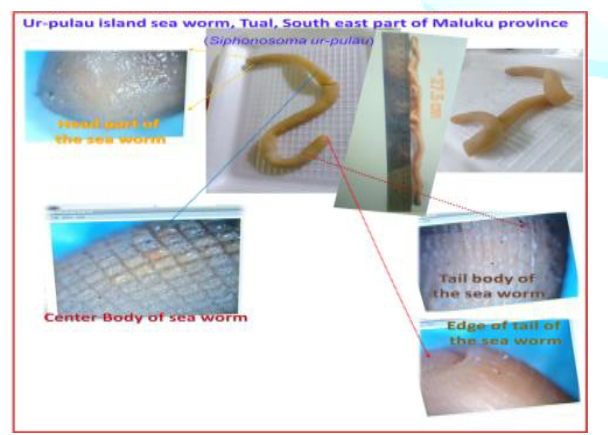
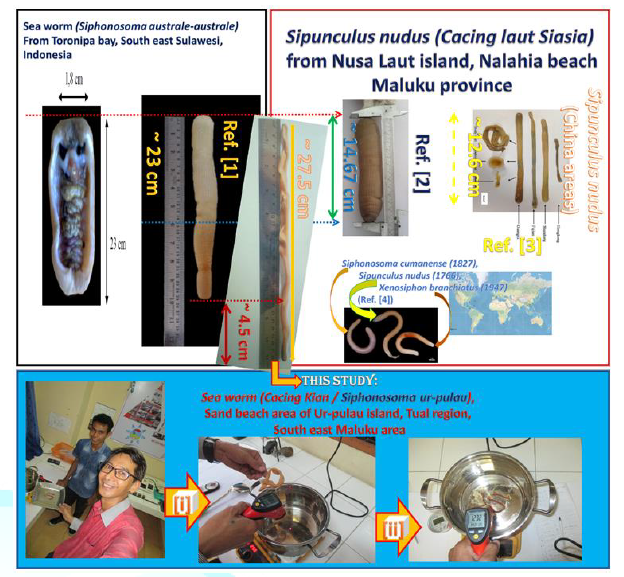
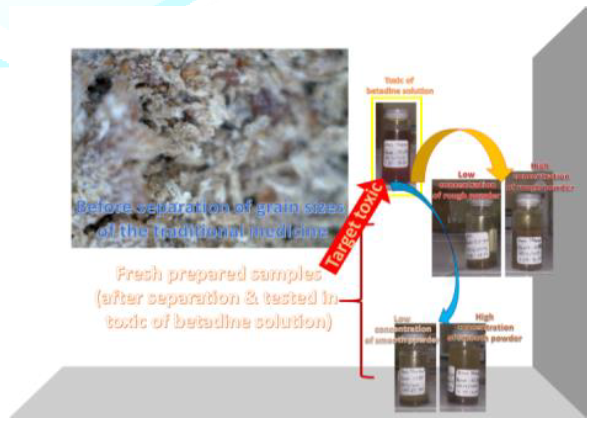
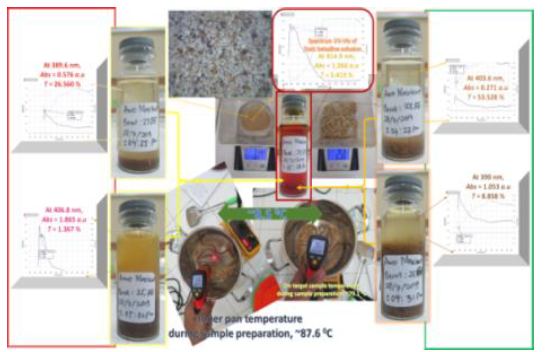
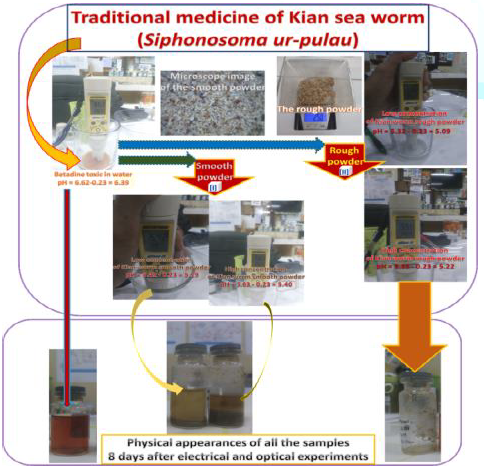
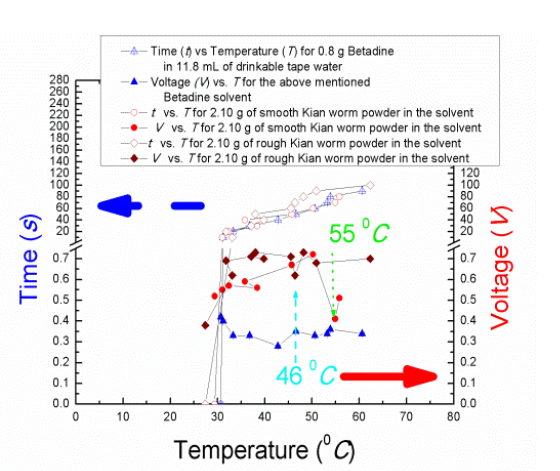
Conclusion
Acknowledgement
26. Ge HY, Chen YY, Zhou GS, Liu X, Tang PY et al. A Novel
Antithrombotic Protease from Marine Worm Sipunculus Nudus (2018) Int. J. Mol.
Sci 19: 3023. https://doi.org/10.3390/ijms19103023 Keywords